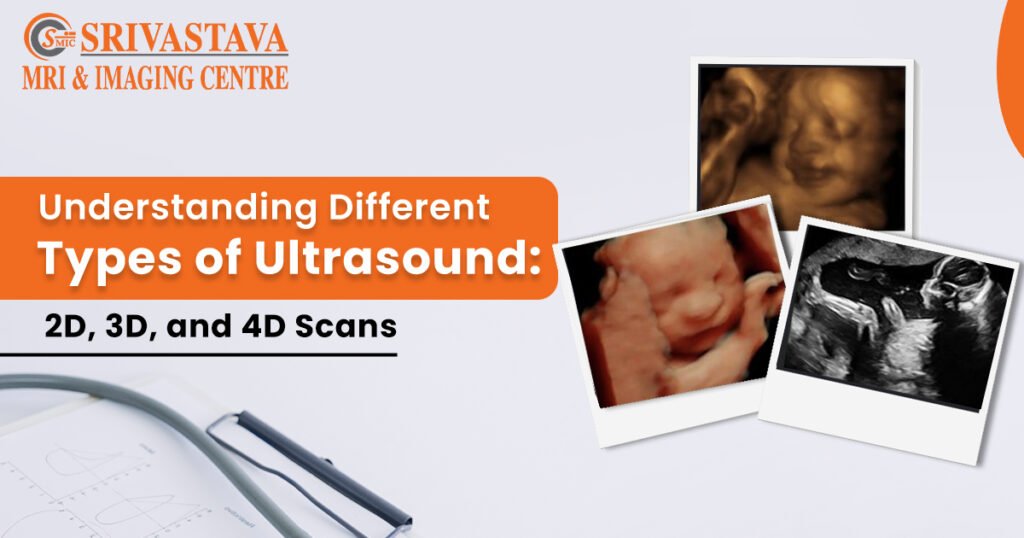Ultrasound imaging has become a cornerstone in medical diagnostics, offering a non-invasive way to view internal organs and monitor the health of an unborn baby. The technology behind ultrasound has advanced significantly, leading to the development of 2D, 3D, and 4D scans, each with its applications and benefits. If you’re looking for an Ultrasound Centre near AIIMS Hospital, consider Srivastava MRI & Imaging Centre, a trusted name that provides high-quality diagnostic services.
2D Ultrasound: The Traditional Approach
2D ultrasound is the most commonly used type of scan and has been the standard in medical imaging for decades. This method produces flat, two-dimensional, black-and-white images of the inside of the body. The sound waves are sent into the body, and the echoes that bounce back create a visual representation on the screen.
Applications:
- Pregnancy: In obstetrics, 2D ultrasounds are typically used to monitor the development of the fetus, check for abnormalities, and determine the baby’s sex.
- Medical Diagnostics: Beyond pregnancy, 2D ultrasounds examine internal organs like the heart, liver, kidneys, and blood vessels. It’s a vital tool for diagnosing conditions such as gallstones, kidney stones, and heart issues.
Advantages:
- Safety: 2D ultrasounds are completely safe for both the mother and the baby.
- Accessibility: This type of ultrasound is widely available and affordable, making it accessible to most patients.
3D Ultrasound: A New Dimension
3D ultrasound takes imaging a step further by creating three-dimensional images. It compiles multiple 2D images taken at different angles to generate a detailed 3D image of the fetus or organ. This technology allows for better visualization of structures and can provide more accurate measurements.
Applications:
- Pregnancy: In obstetrics, 3D ultrasounds are often used to view the baby’s facial features and detect any potential abnormalities, such as cleft lip or spinal issues.
- Medical Diagnostics: 3D ultrasounds can be used to visualize tumours, cysts, or other abnormalities in organs, providing a more accurate assessment compared to 2D scans.
Advantages:
- Enhanced Visualization: The 3D images offer a more detailed view, which can help in diagnosing conditions more accurately.
- Emotional Bonding: Expectant parents often appreciate the ability to see their baby’s features in detail, which can enhance emotional bonding.
4D Ultrasound: The Next Level
4D ultrasound is essentially a 3D ultrasound in motion. It captures real-time video of the fetus or organ, allowing for the observation of movements and behaviours. This dynamic imaging is particularly useful in obstetrics, where parents can watch their baby move, yawn, or even smile.
Applications:
- Pregnancy: 4D ultrasounds are primarily used to observe the baby’s movements in real time, providing an unforgettable experience for parents.
- Medical Diagnostics: While less common, 4D ultrasounds can be used in complex cases where movement of the organ or fetus is important for diagnosis.
Advantages:
- Real-Time Imaging: The ability to see movements in real time can provide additional insights that static images might miss.
- Parental Experience: Many parents find the experience of watching their baby move in the womb deeply emotional and reassuring.
Choosing the Right Ultrasound
The type of ultrasound you need depends on your specific medical requirements. If you’re in search of an Ultrasound Centre near AIIMS Hospital, Srivastava MRI & Imaging Centre offers state-of-the-art ultrasound services, including 2D, 3D, and 4D scans. Their experienced professionals ensure accurate diagnostics and a comfortable experience for every patient.
Ultrasound technology continues to evolve, offering more detailed and dynamic images that enhance both medical diagnostics and the prenatal experience. Whether you’re expecting a baby or need a detailed examination of an organ, understanding the differences between 2D, 3D, and 4D ultrasounds can help you make an informed decision about your healthcare.



